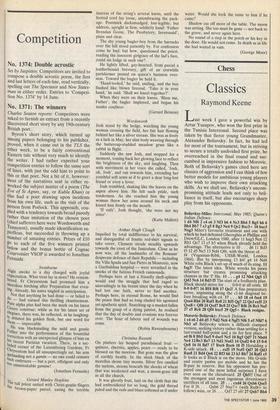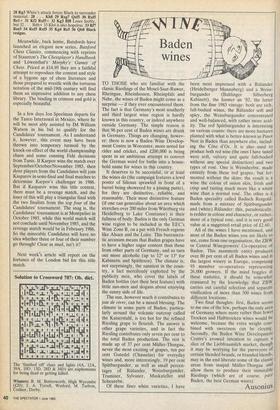Chess
Classics
Raymond Keene
Last week I gave a powerful win by Artur Yusupov, who won the first prize in the Tunisia Interzonal. Second place was taken by that fierce young Grandmaster, Alexander Beliaysky. In fact, he had led for most of the tournament, but in striving to secure a totally undivided first prize, he overreached in the final round and suc- cumbed in impressive fashion to Morovic. Both of Beliaysky's games cited here are classics of aggression and I can think of few better models for ambitious young players who wish to improve their own attacking skills. As we shall see, Beliaysky's uncom- promising attitude leads not only to bril- liance in itself, but also encourages sharp play from his opponents.
Beliavksy-Miles: Interzonal, May 1985; Queen's Indian Defence.
1 d4 Nf6 2 c4 e6 3 Nf3 b6 4 Nc3 Bb4 5 Bg5 h6 6 Bh4 Bbl 7 e3 g5 8 Bg3 Ne4 9 Qc2 Bxc3+ 10 bxc3 Nxg3 Miles's favourite treatment and one with which he had defeated Gheorghiu at Phillips and Drew/GLC, London 1980, after 11 hxg3 Nc6 12 Rbl Qe7 13 c5 h5 when Black already held the advantage. The alternative is 10 . . . d6 11 Bd3 f5 12 d5 Nc5 13 Nd4 Qf6, with the threat of . . . f4 (Vaganian-Ribli, USSR-World, London 1984). But by interposing 13 h41 $4 14 Nd4 White robs Black's set-up of much of its sting. 11 fxg3! The latest idea. White wrecks his pawn structure but creates promising attacking chances in the 'f' file. 11 . . . g4 12 Nh4 Qg5 13 Qd2 Nc6 14 Bd3 f5 The start of a foolhardy plan. Black should strive for . . . 0-0-0 at all costs. 15 0-0 0-0?! 16 Rf4 Rf6 17 Qe2! A fine preparatory move, unpinning along the cl-h6 diagonal be- fore breaking with e4. 17 . . . h5 18 e4 fxe4 19 Qxe4 Rh6 20 Rafl Re8 21 Rf5 Qg7 22 Qe3 exf5 23 Qxe8+ Qf8 24 Qxd7 Bc8 25 Qxc7 Rf6 26 Rel Nay 27 c5 Rc6 28 Qf4 bxc5 29 Qg5+ Black resigns.
Morovic-Beliaysky: French Defence.
1 e4 e6 2 d4 d5 3 Nd2 Nc6 4 Ngf3 Nf6 5 e5 Nfd7 6 Nb3 a5 Beliaysky selects a difficult cramped version, seeking victory rather than settling for a last-round half-point and a tie for first place. 7 a4 f6 8 Bb5 fxe5 9 dxe5 Nc5 10 Bg5 Qd7 11 Nbd4 Ne4 12 Be3 Bel 13 Nd2 Nxd2 14 Qxd2 0-0 15 0-0 Qe8 16 f4 Bd7 17 Bxc6 Bxc6 18 f5 Heralding a K-side attack. 18 . . . exf5 19 Nxt'S Qd7 20 Qd3 Rae8 21 Bd4 Qe6 22 Rf3 b6 23 b3 Bb7 24 Rafl c5 It looks as if Black is on the move. His 0-side and centre pawns are mobile and he has the B-pair in reserve. But his opponent has pre- pared one of the most lethal surprises I have ever seen on the chessboard. 25 Qb5lI One of the strongest and most ingenious diversionary sacrifices of all time. 25 . . . cxd4 26 Qxb6 Qxe5 For if 26 . . . Qxb6 27 Nxe7+ (with Rxf8 + to follow) wins, or 26 . . . Qd7 27 e6! 27 Qxb7 Bb4 28 Rg3 White's attack forces Black to surrender material. 28 ... Kh8 29 Rxg7 QxfS 30 RxfS Rel+ 31 Kf2 RxfS+ 32 Kg3 Bf8 Loses feebly, but 32 . . . Bd6+ 33 Kh4 is also hopeless. 33 Rt7 ReeS 34 RxfS RxfS 35 Kg4 Re5 36 Qb8 Black resigns.
Meanwhile, back home, Batsfords have launched an elegant new series, Batsford Chess Classics, commencing with reprints of Staunton's The Chessplayer's Handbook and LOwenthal's Morphy's Games of Chess. Priced at £14.95 they are a faithful attempt to reproduce the content and style of a bygone age of chess literature and those prepared to wrestle with the tortuous notation of the mid-19th century will find them an impressive addition to any chess library. The binding in crimson and gold is especially beautiful.
In a few days Jon Speelman departs for the Taxco Interzonal in Mexico, where he will be most ably assisted by IM William Watson in his bid to qualify for the Candidates' tournament. As I understand it, however, this event may have been thrown into temporary turmoil by the knock-on effect of the world championship chaos and some cunning Fide decisions from Tunis. If Karpov wins the match over September/October/November 1985, then three players from the Candidates will join Kasparov in semi-final and final matches to determine Karpov's challenger in 1986. But if Kasparov wins this title contest, there must be a revenge match, and the loser of this will play a triangular final with the two finalists from the top four of the Candidates' tournament. The snag is, the Candidates' tournament is at Montpelier in October 1985, while this world match will not conclude until November 1985, and the revenge match would be in February 1986. So the miserable Candidates will have no idea whether three or four of their number go through! Clear as mud, isn't it?
Next week's article will report on the fortunes of the London bid for this title match.



















































 Previous page
Previous page